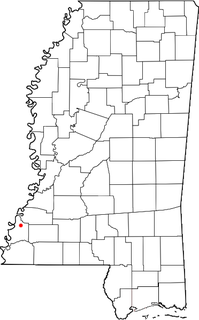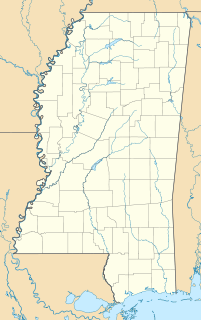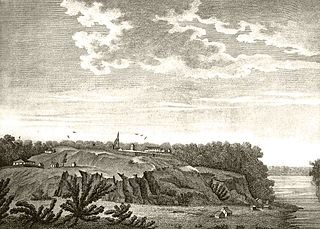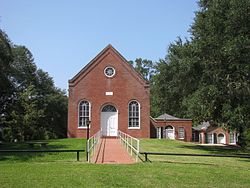
Washington is an unincorporated community in Adams County, Mississippi, United States. The community is close to Natchez. Located along the lower Mississippi River, it was the second and longest-serving capital of the Mississippi Territory.

McLaurin is a small unincorporated community in Forrest County, Mississippi.

Fort Rosalie was built by the French in 1716 within the territory of the Natchez Native Americans and it was part of the French colonial empire in the present-day city of Natchez, Mississippi.

Church Hill is a small unincorporated community in Jefferson County, Mississippi, United States. It is located eight miles east of the Mississippi River and approximately 18 miles north of Natchez at the intersection of highway 553 and Church Hill Road. Church Hill was a community of wealthy cotton planters before the American Civil War. Soil erosion, which had been going on since well before the Civil War, caused the area to decline into a poor farming community with none of the land under cultivation by 1999. The area is remarkable because its antebellum buildings are mostly intact with few modern buildings having been built.

Franklin is an unincorporated community located in Holmes County, Mississippi. Mississippi Highway 17 passes through Franklin, which is approximately 7 miles (11 km) south of Lexington and approximately 12 miles (19 km) north of Pickens.

Independence is an unincorporated community in Tate County, Mississippi, United States.

Pine Ridge Church is a historic church in Pine Ridge, Mississippi, north of Natchez.

Red Lick is an unincorporated community located in Jefferson County, Mississippi. Red Lick is approximately 5 miles (8.0 km) southeast of Lorman on Mississippi Highway 552.

Kirkville is an unincorporated community in Itawamba County, Mississippi, United States.

Wool Market is an unincorporated community in Harrison County, Mississippi. Wool Market is approximately 2.7 miles (4.3 km) northwest of Biloxi and part of the Gulfport-Biloxi metropolitan area.
David Hunt (1779-1861) was an American planter based in the Natchez District of Mississippi who controlled 25 plantations, thousands of acres and more than 1,000 slaves in the antebellum era. From New Jersey, he joined his uncle in Mississippi business. He became a major philanthropist in the South, contributing to educational institutions in Mississippi, as well as the American Colonization Society and Mississippi Colonization Society, of which he was a founding member.

Winchester is a ghost town in Wayne County, Mississippi, United States.

Uniontown is a ghost town in Jefferson County, Mississippi, United States.

Oakland College was a Presbyterian-affiliated four-year college reserved for whites; it operated from 1830 to 1861 near Lorman, Mississippi. After years of closure during the American Civil War of 1861–1865 and a failure to reorganize following the war, it was closed down.

Perkinsville is a ghost town in Winston County, Mississippi, United States.
The Leota Plantation was a historic Southern plantation on the banks of the Mississippi River in Washington County, Mississippi. It was established in 1825 and destroyed by a flood in 1930.

Binnsville is a ghost town in Kemper County, Mississippi, United States.

Kingston is an unincorporated community in Adams County, Mississippi, United States.

Cannonsburg is an unincorporated community in Jefferson County, Mississippi, United States.











